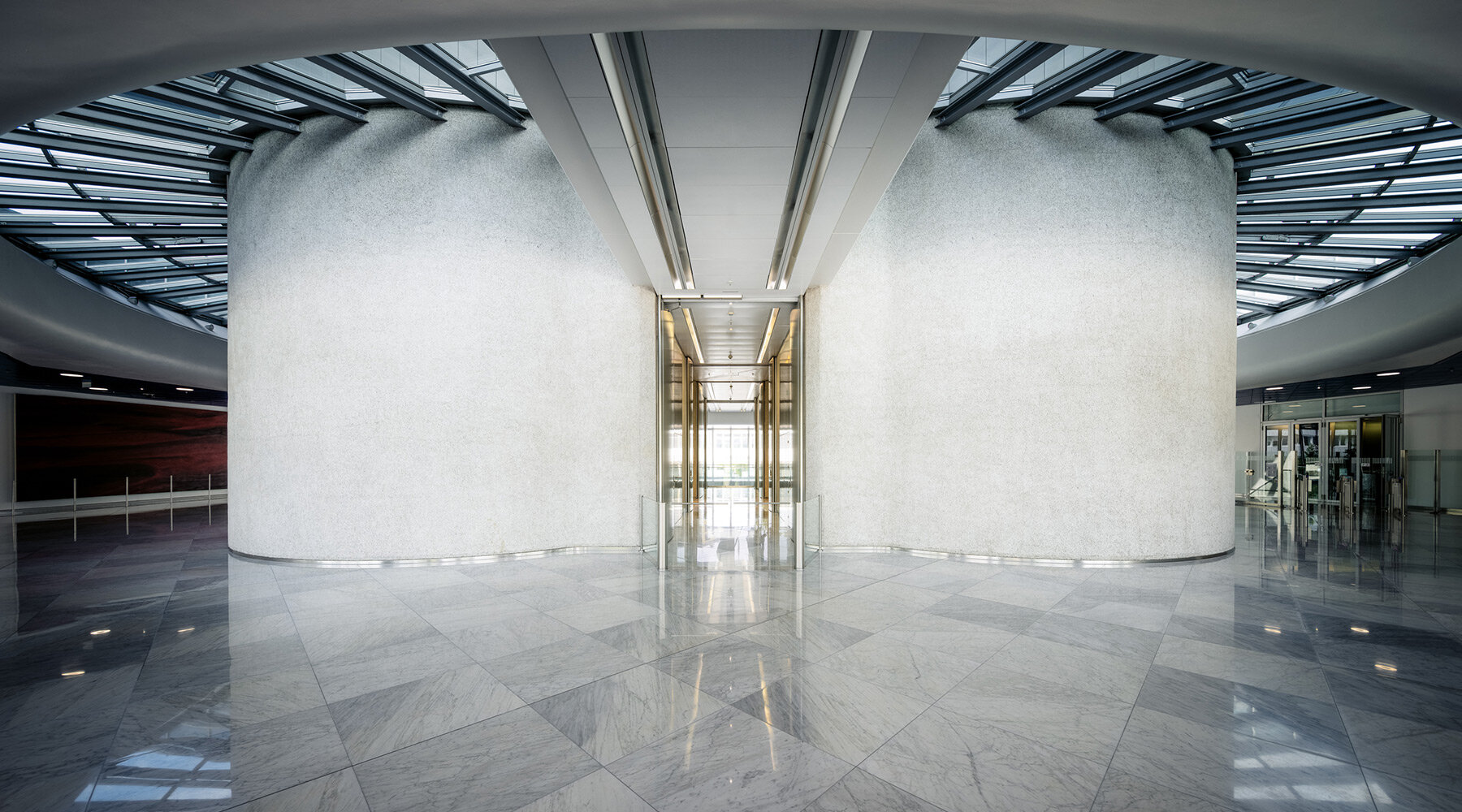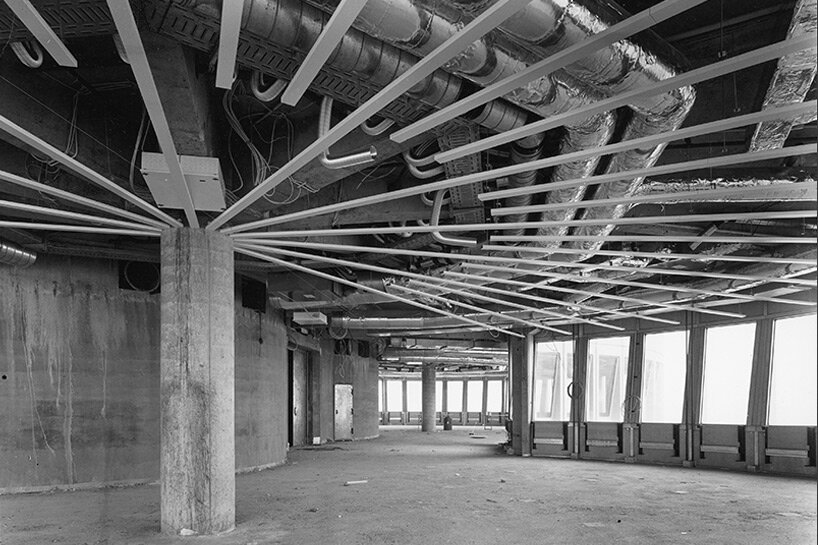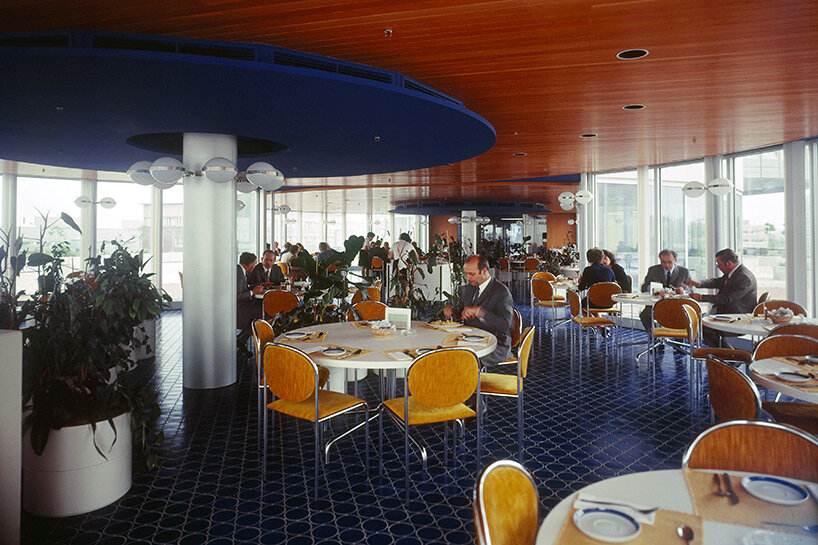50 years of BMW headquarters: munich’s landmark is celebrated
The biggest four-cylinder building in the world – BMW headquarters celebrates its 50 years standing as a landmark for Munich. Conceived as a milestone in the history of architecture, the pioneering project designed by architect Professor Karl Schwanzer in 1972 has become a permanent feature for the city’s skyline and the company’s corporate image. Together with the adjoining museum, a timeless spirit unravels.
Discover BMW’s 50 year journey and celebrations with designboom.

the BMW Museum in front of the Four Cylinder building by Karl Schwanzer | photo by BMW Werkfoto
all images courtesy of BMW AG
The BMW Headquarters and adjoining museum complex not only marked the high point of Karl Schwanzer’s architectural career, they also set new benchmarks in the field of modern office architecture in the early 1970s. The Viennese architect’s design combined an impressive façade with an innovative and flexible spatial concept, and in doing so laid the foundations for an enduring architectural philosophy at BMW. Schwanzer’s tower furthermore epitomizes West German architectural design influencing since then upcoming civil engineering projects. Given its identity as an intriguing structure, the Tower marks an achievement of its period and continues to fascinate admirers to this day.
‘This is not a normal architecture. This is industrial construction – engineering construction. You do not have bricks that you mount together as you did centuries before. The building has a height of 99.5 meters.We have a strange law in Munich that says that our main cathedral, a wonderful Gothic building, has a height of 90.8 meters, and no other buildings may be as high as the cathedral,’ says Dr. Andreas Braun, curator of the BMW Museum, while standing right in front of the Headquarters.

“Topping out” ceremony – address by Professor Karl Schwanzer (close-up photo from the righthand side), 1971 | photo by BMW Werkfotograf Attenberger, Karl
the competition that started it all
In April 1968, the BMW executive management launched a competition with a view to choosing a design for the new head office and invited eight architects with a proven track record in similar projects. The spatial planning had to take account of technological advances in administration and production and the continual changes these brought to workflows. Moreover, the new administrative complex required dimensions and a design that would not only reflect the importance of the company, but also blend in with other architecture around it. This consisted of residential buildings, the BMW plant, major traffic junctions and the future Olympic facilities. The judges were struck by architect Professor Karl Schwanzer’s 100-meter-high design and the rest is history.

looking up to the four cylinders | image © designboom
Karl Schwanzer’s design drafts for the BMW Headquarters reveal the influence of his teacher, Oscar Niemeyer, as the similarity in the sculptural element of both the BMW Tower and the Brazilian architect’s Museum Bowl is evident. The Tower has a cloverleaf floor plan and forms both the high point and center of the ensemble of new buildings, while its height of 99.5 m was within the maximum stipulated by Munich’s inner city planning regulations in 1968. This restriction was based on the height of the towers of Munich’s Frauenkirche, which rise to 98.6m; the height of a building could not exceed 100 m. Its 22 stories are divided into 18 office floors, including two for the Board of Management, four technical floors, the ground floor and a basement.
‘This is not a normal architecture. This is industrial construction, engineering construction. You do not have bricks that you mount together as you did centuries before. The building has a height of 99.5 meters.We have a strange law in Munich that says that our main cathedral, a wonderful Gothic building, has a height of 90.8 meters, and no other buildings may be as high as the cathedral,’ says Dr. Andreas Braun, curator of the BMW Museum, while standing right in front of the Headquarters.

construction of the BMW ” Four Cylinder” – the core of the building, 1970 | photo by BMW Werkfotograf Attenberger, Karl
BMW headquarters: the upside-down building arises
Instead of resting on foundations, the building was designed to be suspended from a cruciform steel beam construction on the roof. There were only a handful of examples of this type of suspended building worldwide, and none had ever been built to the height of Schwanzer’s design. In construction terms this meant that rather than being built conventionally from the bottom upwards, first the upper floors of the almost 100-metre-high building were completed. The four cylindrical elements were initially constructed at ground level, before being raised hydraulically and completed in several segments.

looking up the Tower | photo by Myrzik and Jarisch
Each cylinder was suspended from four giant crane arms positioned in the shape of a cross at the building’s central core, a tower shaft made of reinforced concrete and resting on very solid foundations. The major tensile and compression forces were absorbed by lattice girders made of reinforced concrete on a mezzanine level in the top third of the building and by vertical ties and compression columns running along the exterior façades – lending the entire design stability. This approach to design and construction gave the BMW Tower a light and distinctive silhouette, despite its impressive height and a suspended weight of 16,800 tons.

inside the BMW Headquarters | photo by Myrzik and Jarisch
stepping inside the four cylinders
What the directors initially regarded as too futuristic, too far removed from practical applications and too experimental, was ultimately considered the optimal solution: a circular floor plan of four office segments on each level, created by the four individual suspended columns of the Tower, which form the cloverleaf shape of the external floor plan of the administration building. The architect himself based his reasoning for the shape of the building exclusively on the logical rationality and functionality of a circular floor plan for the modern organizational approach to office work. In Karl Schwanzer’s view, the cloverleaf floor plan resulted in the following characteristics for modern office design: short routes to optimize lines of communication and office organization between the individual departments, and maximum flexibility in configuring available space.

entrance hall of the BMW “Four Cylinder”, 1973 | photo by Neubert Sigrid
a new floor was constructed every week
Two and a half months after the start of construction, the foundations of the Tower and two floor levels above the basement were in place. Four months later, the core of the Tower had been raised to the full height of almost 100 m using the Simcrete slipform process. Next came the load-bearing cross at the top of the Tower from which the floors were suspended using pre-stressing steel tendons, raised by a hydraulic press at a rate of four meters per week. A new floor could be prepared each week and hoisted up to the completed ones above, with glazing and façade work progressing at the same time. In this way the four cylindrical segments of the building rose uniformly from the ground at the same pace. Thanks to prefabrication, the Tower went up with impressive speed.
‘For the towers, the two elevators were first constructed for the 22 floors. Every floor was presented on the ground with almost everything, and with hydraulic help, each one was put up. The 22nd floor was put up first and all the others were put under that. So there you have it- the building was constructed the other way around. This process saved a lot of time actually as this only took 24 months to realize,’ explains Dr. Andreas Braun.

construction of BMW ” Four Cylinder”, 1971 | photo by Neubert Sigrid
The BMW Headquarters today
The BMW Headquarters was state-of-the-art in the early 1970s, a symbol of cutting-edge architecture and a test site for new, pioneering ideas geared to in-house cooperation. After 30 years of service, the building needed to be adapted to the changing technical and architectural requirements of a global company. Today, the Tower is virtually unchanged in terms of its external appearance and on the inside remains as spectacular and futuristic as it was 50 years ago.

the Tower lights up Munich’s skyline at night

Construction of the BMW Tower, 1972-1973 | photo by Neubert Sigrid


aerial picture: Building core of the BMW Tower shrouded in fog, 1970 | photo by Pömmerl Hans

“Topping out” ceremony for the Tower – setting up the tree to be used for the ceremony, 1971 | photo by Deltapress

looking towards the north-west side of the Tower, 1973 | photo by Neubert Sigrid

entrance level of the Headquarters





project info:
brand: BMW
building: BMW Headquarters
design: Professor Karl Schwanzer
construction: 1970-1972
cost: approx. DM 100 million
height: 99.6m
floors: 22 (18 office floors in tower)
building plot: 14,730 m2
architecture in germany (305)
BMW (281)
PRODUCT LIBRARY
a diverse digital database that acts as a valuable guide in gaining insight and information about a product directly from the manufacturer, and serves as a rich reference point in developing a project or scheme.












